TANCET MBA Question Paper-2010
PART-I
Directions (Qns. 1-20): This section comprises of two passages. After each passage questions consisting of items relating to the preceding passage are given. Evaluate each items separately in terms of the respective passage and choose your answer as per the following guidelines:
(A) If the item is a MAJOR OBJECTIVE in making the decision; that is the outcome or result sought by the decision maker.
(B) If the items is a MAJOR FACTOR in arriving at the decision; that is consideration explicitly mentioned in the passage that is basic in determining the decision.
(C) If the item is a MINOR FACTOR in making the decision; a less important element bearing on or affecting a Major Factor, rather than a Major Objective directly.
(D) If the item is a MAJOR ASSUMPTION made deliberately; that is supposition or projection made by the decision maker before considering the factors and alternatives.
(E) If the item is an UNIMPORTANT ISSUE in getting to the point; that is a factor that is insignificant or not immediately relevant to the situation.
PASSAGE-I
The success of the Ashoka Enterprises in Bhutan was recently the subject of a government inquiry. It is a developing country about the size of Delhi with a population of ten million people. It has a small but growing industrial base, and several multinational business concerns have established manufacturing plants in various parts of the country.
The Government of Bhutan has always favoured foreign investment. Leaders of all political parties have been virtually unanimous in their belief that foreign investment would contribute to speed country’s economic development. Of special interest to the government were those industries that exported a significant share of their total output. Since Bhutan has a relatively small population, there is a limit to the amount of goods that could be produced for the local market. Also, the government did not want to encourage foreign investors to compete with local industry, even though new industries might alleviate the already high unemployment rate.
A final reason for encouraging export-intensive industries was to earn badly needed foreign exchange. Bhutan had a chronic deficit in its balance of trade; that is, its imports were regularly greater than its exports. This meant that it had to use scarce foreign exchange to pay for the growing deficit. Therefore, Bhutan welcomed potential investors that would promise to export a significant share of their total output. So, when the executives of Ashoka Enterprises proposed to establish a shoe manufacturing plant which would be export-intensive, it received ready approval from t he government.
The Government support for the enterprises was given not only because of the promise to export, but also because of the high unemployment rate in the country. However approval was given despite the fact that there was at the time surplus show production, most factories having large excess capacities and underworked labour forces. It was known that the Ashoka Enterprises h ad promised the government, among other things, to employ hundred workers, to reduce the price of shoes by some 30 percent, and to export more than half its output.
In return for these promises, the Enterprises received the following concessions from the government :
(a) Land was given to the company on a lease basis for a period of 99 years, rent-free.
(b) A government-owned contracting firm built the factory at low subsidized prices.
(c) The company received loans at very low interest rates for an extended period of time. Those loans could be renewed at company’s request at lower than the prevailing market interest rate.
(d) The government trained workers at the plant at no expense to the company.
Production commenced one year after the first equipment arrived at the new plant. It took another half year to properly train te new work force to operate the sophisticated equipment which was introduced. After the “running in” period, production continued smoothly for about a year until a labour dispute occurred. It appeared that management wanted to dismiss about 10 percent of the work force owing to what a company spokesman called “a temporary slack in demand” for their products. The labour union representing the company’s work force refused to accept any reduction in the work force and threatened a strike if services of the workers were terminated. After some discussion, union representatives agreed that the company might be justified in laying off some workers, but nowhere near the 10percent figure that management desired. At any rate, the union claimed that the company must first submit its request to a joint union-management grievance committee which was authorized under the current labour agreement to deal with such disputes. Management acquiesced to the union demand. After several days of bargaining, an agreement was worked out whereby the company would be allowed to terminate post part-time workers, amounting to only one percent of the total work force. Although the agreement brought about a temporary solution to the current, problem labour-management relation continued to be strained, as management was convinced that more workers were redundant than the union cared to admit.
After another six months, it became apparent tht what management had termed “a temporary slack in demand” was in reality a failure of the company to sell the quantity of shoes that has been forecast before production began. Actual sales never reached the target quantity, and as a result, the company lost rupees one million in each of its first two years of operation. The American representatives on the board of directors – who constituted a majority – voted to discontinue the company’ operation in Bhutan. Shortly after the vote, bankruptcy hearing began.
As the company was located in an underdeveloped area of the country, the government was worried about the political ramifications if production ceased. The company employed 500 workers, and quite a few shopkeepers were dependent upon their patronage. When government representatives asked the company’s management what could be done to keep the company operating, they received the following reply. Management was willing to continue production if the government granted the company an additional five-million rupees loan on favourable terms. If the government could not grant such a loan, then another alternative was to purchase the company at a “reasonable” price.
The government was in a dilemma. On the one hand, it was concerned about the political consequences if the company should continue the bankruptcy proceedings. On the other hand, if it granted the loan, it might be setting a precedent for any other company that was in financial difficulties. Moreover, there was in financial difficulties. Moreover, there was a certain risk involved in lending the money to a company in bad shape. The government appointed a special committee to investigate the financial condition of the company and decide the issue.
One month later, the committee submitted its report. The major finding was that the company had not kept any of its original promises to the government. For one thing, prices of the shoes were not lower than those of any its competitors. As for exports, not only had the company failed to reach its promised goal of 50 percent, but as of the bankruptcy hearings, its exports for a five-year period only amounted to 5 percent of total output. In the light of these developments, the government felt that it had to make a quick decision in such a way as to avoid criticism from the opposition.
1. Ability of Ashoka Enterprises to survive if the five-million-dollar loan was granted.
2. High unemployment in Bhutan.
3. Dependence of shopkeepers on the existence of Ashoka Enterprises.
4. Status of Bhutan as a developing country.
5. Continued operation of Ashoka Enterprises.
6. Training of workers at no expense to Ashoka Enterprises.
7. Strained worker-management relations at Ashoka Enterprisers.
8. Availability of government funds needed to support the company.
9. Prevention of layoffs of workers at the company
10. Political consequence of the company’s bankruptcy.
PASSAGE-II
The Climax Corporation manufactured a line major electrical appliances distributed through sixty wholesalers, many of which were company owned. Retailers carried competitive lines, but wholesalers did not; portable appliance moved to market through nonexclusive distributors.
The company was dependent on wholesalers to provide service either directly or through supervision of retailers service departments. When the warranty was involved, the manufacturer supplied the parts and the wholesaler the labour. Retailers who performed the service function were given a larger discount than those who returned the goods to the wholesaler to fulfill the guarantee.
In 1998, home office officials began questioning the adequacy of the service thus rendered either under the terms of the warranty or independently. Typical retailers carried several brands and, in general, did not have competent service personnel. The result was that the blame for the defect was passed back to the manufacturer. This, said the sales manager, was a major consideration. Others believed that reduction of service costs would follow from centralizing the entire operation in the hands of a relatively few factory service branches or in carefully trained service personnel employed by a relatively few widely distributed wholesalers. Costs would be thus reduced, and at the same time, the quality of service rendered would be enhanced, it was claimed.
The product service manage argued that more money should be spent on training retail sales service personnel. Retailers like to render service, he claimed, since it helps to bring traffic into their stores and thus is profitable. A third possibility explored was the promotion of good service by concerns who service but do not sell appliances.
During the conference, the rise of the discount house was discussed. It was thought to be a phenomenon partly based on the realization that good independent service can b e secured in most markets and for most appliances. There may be an exception in the case of TV sets, it was admitted, since it is common to find great resentment as to quality of service and delay in meeting calls.
The subsequent discussion raised questions as to the validity of the policy of requiring the retailer to give free service time under the terms of the guarantee. Often owners expected to receive this service free, even though they had brought the appliance elsewhere. Some company officials believed that the company should pay dealers for their time costs when they enabled the company to make good on its guarantee. One executive pointed out, during a heated discussion on this point, that at least one major automobile company now paid its dealers for making repairs under the warranty.
About this time the sales manager read about a consumer survey that found that the average owner gave little thought to service availability when buying an appliance, except perhaps in the case of TV sets. But, when trouble arose the owner expected the maker to “stand behind his product” and not fall back on any excuse as to costs or time involved, limitations which are found in the normal warranty.
Climax’s operations manager was given the responsibility to set up a task force which would study each of the alternatives discussed during the conference. The alternatives were to be examined with regard to customer service and cost. The task force was asked to make its recommendations directly to the service manager.
Two of the alternative methods for increasing service were almost immediately discarded as impractical. It was found that retail sales personnel would not have adequate time to devote to servicing appliances. Investing capital in concerns which service but do not sell appliances might increase the level of service, but Climax would have little if any control over their operation. These concerns were independently owned and had no more allegiance to Climax than they did to any number of manufacturers whose appliances they services. Some concerns were highly reliable, but others had a record of spotty service. Weighed against other available alternatives, these options had few benefits to Climax.
It was the conclusion of the operations group that a choice had to be made among three options: (1) factory service branches (2) wholesaler service departments and (3) a combination of both factory and wholesaler service.
The factory service alternative had a number of advantages to Climax. Because Climax would provide the service at its own locations with company personnel, it could closely supervise the quality of the work done. Factory supervision of service was more difficult whenever work was done by independent dealers. Moreover, under the factory system, Climax could ensure that service personnel undergo the most rigorous initial and refresher training programs. Another advantages of centralized factory service was that parts inventories would be minimized by storage in only a few service locations. Finally, under this system, Climax would determine the price of service, thereby ensuring that consumers would not be overcharged.
The major disadvantage of centralized factory service was that Climax would have to invest in service locations, provide parts inventories, and train personnel. Because of the size of this investment, few locations could be established.
Compared to factory service, wholesaler-operated locations would be more difficult to supervise. As a result, the level of service was bound to vary from location to location. Even though the consumer survey indicated that service was not an important consideration in the pre-purchase decision as to whether to buy an appliance, poor service experienced by a customer might lower the chance that a Climax appliance would be bought again.
Wholesaler service would require less investment for Climax. Although Climax would have to take some of the responsibility for training wholesaler personnel, it would not have to invest in service locations nor in inventory parts. Initial investment and operating costs would not limit the number of service centers as it would in the case of factory service. Many of the wholesalers would be eager to offer the service as an added customer benefit. Climax’s investment would be even smaller if service facilities were maintained by independent, non-factory-owned wholesalers.
A final alternatives was combination of both factory service centers and wholesaler-operated service departments. Under this option, wholesalers would be encouraged to offer service whenever possible, while Climax would maintain centralized service centers in areas where wholesaler service was inadequate or spotty.
11. Training of retail service personnel.
12. The rise of the discount house.
13. Lack of competent service personnel at most typical retailers.
14. Technical level of service demanded by consumers.
15. Centralization of the service operation.
16. Increasing the level of service.
17. Consumer belief that manufacturers are responsible for product defects.
18. Investment required in service centers under each plan.
19. Consumer pre-purchase decisions.
20. Increase in store traffic due to service calls.
PART-II
Directions (Qns. 21-30): Each passage in this section is followed by questions based on its contents. Read the passages carefully and then answer the questions given below them by choosing the best answer to each question. Answer the questions on the basis of what is stated or implied in the passages.
PASSAGE-I
It I s indisputable that in order to fulfill its many functions, water should be clean and biologically valuable. The costs connected with the provision of biologically valuable water for food production with the maintenance of sufficiently clean water, therefore, are primarily production costs. Purely “environmental” costs seem to be in this respect only costs connected with the safeguarding of cultural, recreational and sports functions which the water courses and reservoirs fulfill both in nature and in human settlements.
The pollution problems of the atmosphere resemble those of the water only partly. So far, the supply of air has not been deficient as was the case with water, and the dimensions of the air-shed are so vast that a number of people still hold the opinion that air need not be economized. However, scientific forecasts have shown that the time may be already approaching when clear and biologically valuable air will become problem No. 1.
Air being ubiquitous, people are particularly sensitive about any reduction in the quality of the atmosphere, the increased contents of dust and gaseous exhalations, and particularly about the presence of odors. The demand for purity of atmosphere, therefore, emanates much more from the population itself than from the specific sectors of the national economy affected by a polluted or even biologically aggressive atmosphere.
The households’ share in atmospheric pollution is far bigger than that of industry which, in turn, further complicates the economic problems of atmospheric purity. Some countries have already collected positive experience with the reconstruction of whole urban sectors on the basis of new heating appliances based on the combustion of solid fossil fuels; estimates of the economic consequences of such measures have also been put forward.
In contrast to water, where the maintenance of purity would seem primarily to be related to the costs of production and transport, a far higher proportion of the costs of maintaining the purity of the atmosphere derives from environmental considerations. Industrial sources of gaseous and dust emissions are well known and classified; their location can be accurately identified, which makes them controllable. With the exception, perhaps, the elimination of sulphur dioxide, technical means the technological processes exist which can be used for the elimination of all excessive impurities of the air from various emissions.
Atmospheric pollution caused by the private property of individuals (the dwellings, automobiles, etc.) is difficult to control. Some sources such as motor vehicles are very mobile, and they are thus capable of polluting vast territories. In this particular case, the cost of anti-pollution measures will have to be borne, to a considerable extent, by individuals, whether in the form of direct costs or indirectly in the form of taxes, dues, surcharges, etc.
The problem of noise is a typical example of an environmental problem which cannot be solved passively, i.e., merely by protective measures, but will require the adoption of active measures, i.e., direct interventions at the source. The costs of a complete protection against noise are so prohibitive as to make it unthinkable even in the economically most developed countries. At the same time it would not seem feasible, either economically or politically, to force the population to carry the costs of individual protection against noise for example, by reinforcing the sound insulation of their homes. A solution of this problem probably cannot be found in the near future.
21. According to the passage, the population at large
(A) is unconcerned about air pollution controls
(B) is especially aware of problems concerning air quality and purity
(C) regards water pollution as more serious than air pollution
(D) has failed to recognize the economic consequences of pollution
(E) is unwilling to make the sacrifices needed to ensure clear air
22. Scientific forecasts have shown that clear and biologically valuable air
(A) is likely to remain abundant for some time
(B) creates fewer economic difficulties than does water pollution
(C) may soon be dangerously lacking
(D) may be beyond the capacity of our technology to protect
(E) has already become difficult to obtain
23. According to the passage, which of the following contributes most to atmospheric pollution?
(A) industry
(B) production
(C) households
(D) mining
(E) waste disposal
24. The costs involved in the maintenance of pure water are determined primarily by
I. product costs
II. transport costs
III. research costs
(A) I only
(B) III only
(C) I and II only
(D) II and III only
(E) I, II and III
25. According to the passage, atmospheric pollution caused by private property is
(A) easy to control
(B) impossible to control
(C) difficult to control
(D) decreasing
(E) negligible
26. According to the passage, the problem of noise can be solved through
I. Active measures
II. Passive measures
III. Tax levies
(A) I only
(B) III only
(C) I and II only
(D) II and III only
(E) I, II and III
27. According to the passage the costs of some anti-pollution measures will have to be borne by individuals because.
(A) individuals contribute to the creation of pollution
(B) governments do not have adequate resources
(C) industry is not willing to bear its share
(D) individuals are more easily taxed than producers
(E) individuals demand production, which causes pollution
28. Complete protection against noise
(A) may be forthcoming in the near future
(B) is impossible to achieve
(C) may have prohibitive costs
(D) is possible only in developed countries
(E) has been achieved in some countries
29. In the near future the most vital problem would be
(A) water pollution
(B) environmental costs
(C) availability of clean air
(D) noise problem
(E) vehicular problem
30. According to the passage, the sector that contributes more towards air pollution is
(A) agriculture
(B) power
(C) commercial establishment
(D) household
(E) Industry
PASSAGE-II
When musing on cities over time and in our time, from the first (whenever it was) to today, we must always remembers that cities are artifacts. Forests, jungles, deserts, plains, oceans – the organic environment is born and ides and is reborn endlessly, beautifully, and completely without moral constraint or ethical control. But cities – despite the metaphors that we apply to them from biology or nature (“The city dies when industry flees”; “The neighbourhoods are the vital cells of the urban organism”), despite the sentimental or anthropomorphic devices we use to describe cities – are artificial. Nature has never made a city, and what Nature makes that may seem like a city – an anthill, for instance – only seems like one. It is not a city.
Human beings made and make cities, and only human beings kill cities, r let them die. And human beings kill cities, or let them die. And human beings do both – make cities and unmake them – by the same means; by acts of choice. We enjoy deluding ourselves in this as in other things. We enjoy believing that there are forces out there completely determining our fate, natural forces – or forces so strong and overwhelming as to be like natural forces-that send cities through organic or biological phases of birth, growth, and decay. We avoid the knowledge that cities are at best works of art, and at worst ungainly artifacts – but never flowers or even weeds- and that we, not some mysterious force or cosmic biological system, control the creation and life of a city.
We control the creation and life of a city by the choices and agreements we make – the basic choice being, for instance, not to live alone, the basic agreement being to live together. When people choose to settle, like the stars, not wander like the moon, they create cities as sites and symbols of their choice to stop and their agreement not to separate. Now stasis and proximity, not movement and distance, define human relationships. Mutual defense, control of a river or harbor, shelter from natural forces – all these and other reasons may lead people to aggregate, but once congregated, they then live differently and become different.
A city is not an extended family. That is a tribe or clan. A city is a collection of disparate families who agree to a fiction: They agree to live as if they were as close in blood or ties of kinship as in fact they are in physical proximity. Choosing life in an artifact, people agree to live in a state of similitude. A city is a place where ties of proximity, activity, and self – interest assume the role of family ties. It is a considerable pact, a city. If a family is an expression of continuity through biology, a city is an expression of continuity through will and imagination – through mental choices making artifice, not through physical reproduction.
It is because of this centrality (of the city) that the financial markets have stayed put. It had been widely forecast that they would move out en masse, financial work being among the most quantitative and computerized of functions. A lot of the back-office work has been relocated. The main business, however, is not record keeping and support service; it is people sizing up other people, and the centre is the place for that.
The problems, of course, are immense. To be an optimist about the city, one must believe that it will lurch from crisis to crisis but somehow survive. Utopia is nowhere in sight and probably never will be. The city is too mixed up for that. Its strengths and its ills are inextricably bound together. The same concentration that makes the centre efficient is the cause of its crowding and the destruction of its sun and its light and its scale. Many of the city’s problems, furthermore, are external in origin – for example, the cruel demographics of peripheral growth, which are difficult enough to forecast, let alone do anything about.
What has been taking place is a brutal simplification. The city has been losing those functions for which it is no longer competitive. Manufacturing has moved toward the periphery; the back offices are on the way. The computers are already there. But as the city has been losing functions it has been reasserting its most ancient one; a place where people come together, face-to-face.
More than ever, the centre is the place for news and gossip, for the creation of ideas, for marketing them and swiping them, for hatching deals, for starting parades, This is the stuff of the public life of the city – by no means wholly admirable, often abrasive, noisy contentious, without apparent purpose.
But this human congress is the genius of the place, its reason for being, its great marginal edge. This is the engine the city’s true export. Whatever makes this congress easier, more spontaneous, more enjoyable is not at all a frill. It is the heart of the centre of the city.
31. The author’s purpose in passage is primarily to
(A) identify the sources of popular discontent with cities
(B) define the city as growing out of a social contract
(C) illustrate the difference between cities and villages
(D) compare cities with blood families
(E) persuade the reader to change his behaviour
32. The author cites the sentence “The neighbourhoods are the vital cells of the urban organism” as
(A) an instance of prevarication
(B) a simple statement of scientific fact
(C) a momentary digression from his central thesis
(D) an example of one type of figurative language
(E) a paradox with ironic implications
33. The author’s attitude toward the statements quoted “The city dies when industry flees”; “The neighbourhoods are the vital cells of the urban organism” is
(A) respectful
(B) ambivalent
(C) pragmatic
(D) skeptical
(E) approving
34. According to the author of the passage, why is an anthill by definition unlike a city?
(A) It can be casually destroyed by human beings
(B) Its inhabitants outnumber the inhabitants of even the largest city
(C) It is the figurative equivalent of a municipality
(D) It is a work of instinct rather than of imagination
(E) It exists on a far smaller scale than any city does
35. Mutual defense, control of waterways, and shelter from the forces of nature are presented primarily as examples of motives for people to
(A) move away from their enemies
(B) build up their supplied of armament
(C) gather together in settlements
(D) welcome help from their kinfolk
(E) redefine their family relationships
36. We can infer from the passage that roving tribes differ from city dwellers in that these nomads
(A) have not chosen to settle in one spot
(B) lack ties of activity and self-interest
(C) are willing to let the cities die
(D) have no need for mutual defense
(E) define their relationship by proximity
37. By saying a city “is a considerable pact” the author primarily stresses
(A) its essential significance
(B) its speculative nature
(C) the inevitable agreement
(D) the moral constraints
(E) its surprising growth
38. To the author to live in a city is
(A) an unexpected outcome
(B) an opportunity for profit
(C) an act of volition
(D) a pragmatic solution
(E) an inevitable fare
39. Underlying the forecast mentioned in the passage is the assumption that
(A) the financial markets are similar to the city in their need for quantitative data
(B) computerized tasks such as record keeping can easily be performed at remote sites
(C) computerized functions are not the main activity of these firms
(D) the urban environment is inappropriate for the proper performance of financial calculations
(E) either the markets would all move or none of them would relocate
40. The word “scale” in the passage means
(A) series of musical tones
(B) measuring instruments
(C) relative dimensions
(D) thin outer layer
(E) means of ascent
SECTION-III
41. Given that x and y are real numbers, let S(x, y) = x2 – y2. Then S(3, S(3, 4) =
(A) −40
(B) −7
(C) 40
(D) 49
(E) 56
42. In the figure, BD is perpendicular to AC. BA and BC have length ‘a’. What is the area of the triangle ABC?
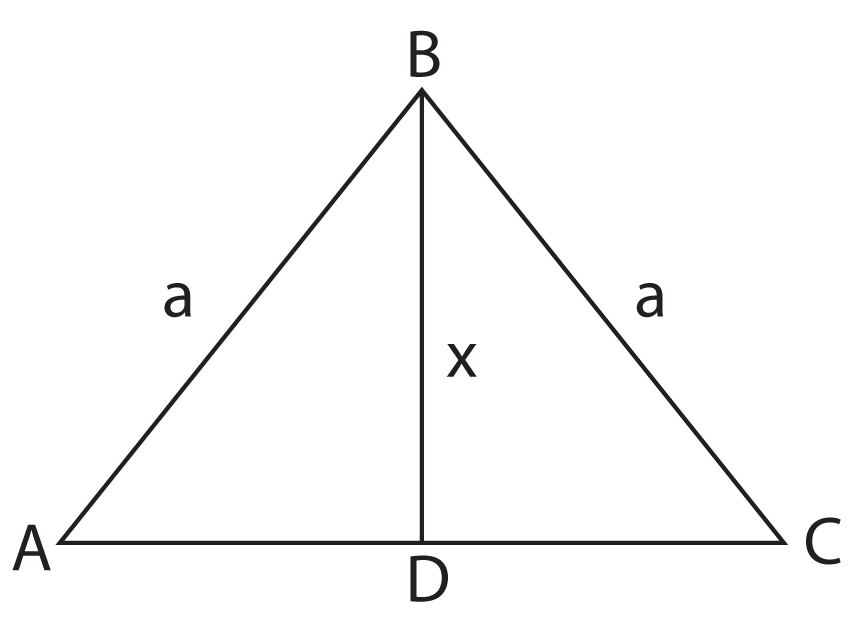
(A) ![]()
(B) ![]()
(C) ![]()
(D) ![]()
(E) ![]()
43. Given that a and b are real number, let f(a, b) = ab and let g(a) = a2 + 2. Then f[3, g(3)] =
(A) 3a2 + 2
(B) 3a2 + 6
(C) 27
(D) 29
(E) 33
44. If x + y + > 5 and x – y > 3, then which of the following gives all possible values of x and only possible values of x?
(A) x > 3
(B) x > 4
(C) x > 5
(D) x < 5
(E) x < 3
45. 36 identical chairs must be arranged in rows with the same number of chairs in each row. Each row must contain at least three chairs and there must be at least three chairs and there must be at least three rows. A row is parallel to the front of the room. How many different arrangements are possible?
(A) 2
(B) 4
(C) 5
(D) 6
(E) 10
46. The hexagon ABCDEF is regular. That means all its sides are of the same length and all its interior angles are of the same size. Each side of the hexagon 2 is feet. What is the area of the rectangle BCEF?

(A) 4 square feet
(B) 4√3 square feet
(C) 8 square feet
(D) 4 + 4√3 square feet
(E) 12 square feet
47. Which one of the following integers has the most divisors?
(A) 88
(B) 91
(C) 95
(D) 99
(E) 101
48. Water is poured into an empty cylindrical tank at a constant rate for 5 minutes. After the water has been poured into the tank, the depth of the water is 7 feet. The radius of the tank is 10 feet. Which of the following is the best approximation for the rate at which the water was poured into the tank?
(A) 44 cubic feet/min
(B) 140 cubic feet/min
(C) 440 cubic feet/min
(D) 700 cubic feet/min
(E) 2,200 cubic feet/min
49. The area of the shaded region shown in the given figure is
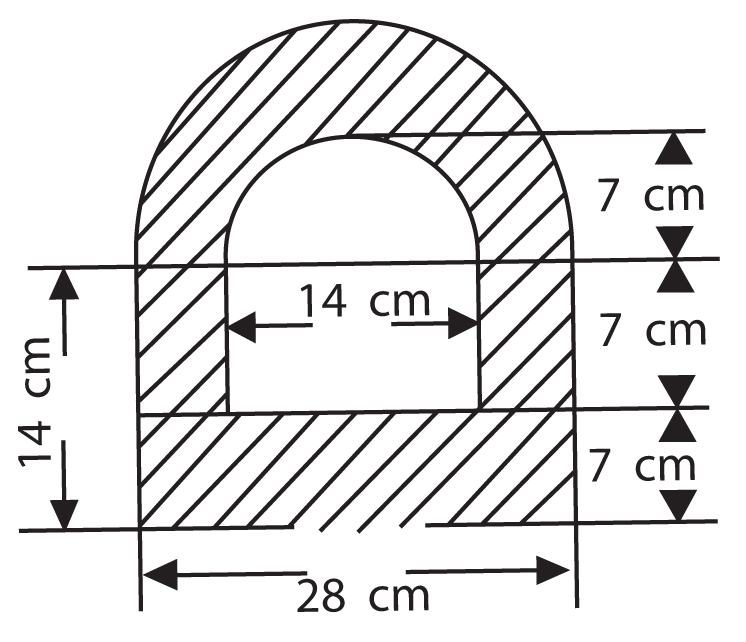
(A) 515 cm2
(B) 535 cm2
(C) 505 cm2
(D) 525 cm2
(E) 545 cm2
50. Starting with a square S1, the squares Sn, n = 2, 3, …. N are constructed by joining the mid-points of the adjacent sides of Sn – 1. If th e side of S1 is of length ‘a’, then the area of SN (in square units), is
(A) a2/2N + 1
(B) a2/N
(C) a2/2N
(D) a2/(√2)N
(E) a2/N2
51. A sphere of a radius r is inscribed in a cube. The volume enclosed between the cube and the sphere is
(A) 
(B) 
(C) 
(D) ![]()
(E) 
52. The value of sin 45° cos 30° + cos 45° sin 30° is
(A) ![]()
(B) ![]()
(C) ![]()
(D) ![]()
(E) None of the above
53. A tent is formed in the shape of a prism of ‘n’ sides surmounted by a pyramid. If the length of each side is ‘a’, the height of the prism is ‘h’ and the height of the pyramid is H, then the capacity of the tent will be
(A) ![]()
(B) ![]()
(C) ![]()
(D) ![]()
(E) ![]()
54. In a class test, the students were asked to solve a quadratic equation. One of the students committed a mistake in copying the constant term of the equation and obtained the roots as 9 and 3. Another student wrote the coefficient of x wrongly and obtained the roots as 7 and − The correct values of the roots are
(A) −9 and −3
(B) −7 and 4
(C) 14 and −2
(D) −14 and 2
(E) −9 and −2
55. Find the greatest number that will divide 19409 and 43037 leaving remainders 17 and 29 respectively
(A) 178
(B) 192
(C) 194
(D) 176
(E) 164
56. What must be the least number of soldiers in a regiment that will allow it to be drawn up into hollow squares 10, 15 or 25 deep and also to be formed into a solid square?
(A) 3600
(B) 3700
(C) 3800
(D) 4000
(E) 5000
57. A train moving with a speed of 40 km per hour takes 2 hours 6 minutes more to cover a certain distance than a train moving at 96 km per hour. What is the distance?
(A) 144
(B) 135
(C) 120
(D) 154
(E) 180
58. If p : q = r : a = t : n =3/5 then mp + nr + ot/mq + nst is equal to
(A) 2
(B) 1
(C) 1/2
(D) ![]()
(E) ![]()
59. 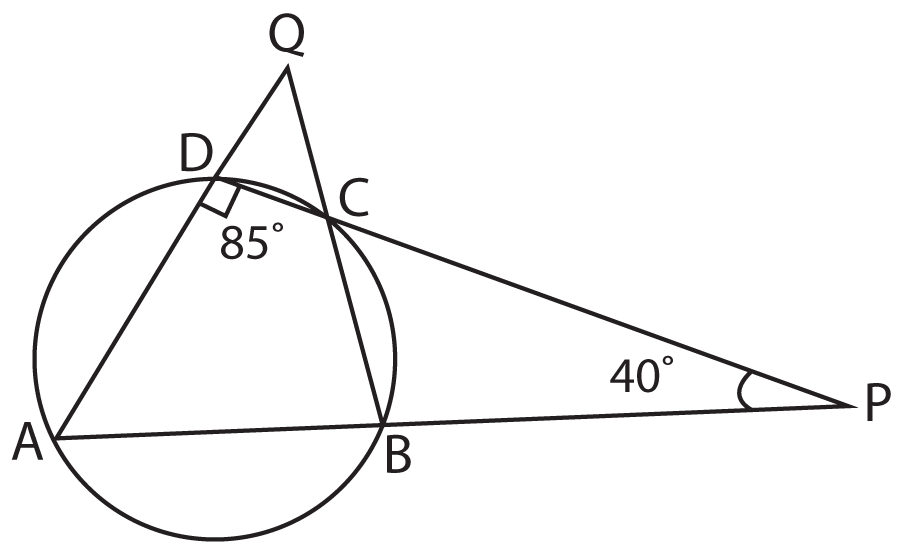
In the above figure the sides of AB and DC of a cyclic quadrilateral ABCD are produced to meet at P. The sides AD and BC are produced to meet at Q. If ∠ADC = 85° and ∠BPC = 40° then ∠BAD is
(A) 55
(B) 60
(C) 70
(D) 65
(E) 40
60. 
In the above figure AD | | BC. The value of x is
(A) x = 8, 9
(B) x = 7, 8
(C) x = 8, 10
(D) x = 7, 10
(E) x = 7, 9
PART-IV
Directions (Qns. 61-80) :Each of the following problems has a question and two statements which are labeled I and II in which certain data are given. You have to decide whether the data given in the statements are sufficient for answering the question. Using the data given in the problem plus your knowledge of mathematics and every day facts, choose:
(A) If you can get the answer from (I) ALONE but not from (II) alone
(B) If you can get the answer from (II) ALONE but not from (I) alone
(C) If you can get the answer from BOTH (I) and (II) TOGETHER, but not from (I) alone or (II) alone
(D) If EITHER statement (I) ALONE or statement (II) ALONE suffices
(E) If you CANNOT get the answer from statement (I) and (II) TOGETHER, but need even more data
61. AC is a diameter of the circle. ACD is a straight line. What is the value of x?
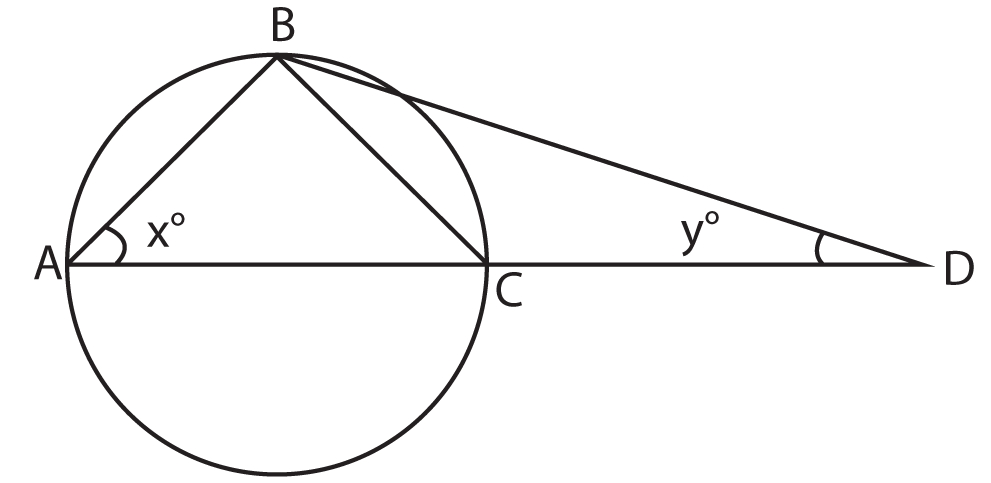
(I) AB = BC
(II) x = 2y
62. Is x a positive?
(I) x2 + 3x – 4 = 0
(II) x > –2
63. How much does John weigh? Tim weighs 100 kg.
(I) Tim’s weight plus Moe’s weight is equal to John’s weight
(II) John’s weight plus Moe’s weight is equal to twice Tim’s weight
64. Is the area of the circle with center O larger than the area of the region outside the circle and inside the square ABCD? The straight line OEF is parallel to AB.
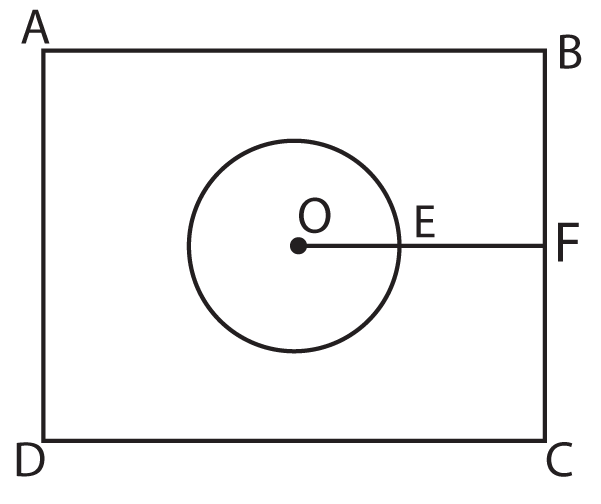
(I) OE < (1/4) AB
(II) EF < (1/4) AB
65. A worker is hired for 6 days. He is paid Rs. 2 more for each day of work than he was paid for the preceding day of work. How much was he paid for the first day of work?
(I) His total wages for 6 days were Rs. 150
(II) He was paid 150% of his first day’s pay for the sixth day
66. A piece of string 6 feet long is cut into three smaller pieces. How long is the longest of the three pieces?
(I) Two pieces are the same length
(II) One piece is 3 feet 2 inches long
67. If a group of 5 craftsman take 3 hours to finish a job, how long will it take a group of 4 apprentices to do the same job?
(I) An apprentice works at 2/3 the rate of a craftsman
(II) The 5 craftsmen and the 4 apprentices working together will take ![]() to finish the job?
to finish the job?
68. AB intersects CD at point O. Is AB perpendicular to CD? AC = AD.

(I) Angle CAD is bisected by AO
(II) BC = AD
69. A car drives around a circular track once. A second car drives from point A to point B in a straight line. Which car travels farther?
(I) The car driving around the circular track takes a longer time to complete its trip than the car travelling in a straight line
(II) The straight line from A to B is ![]() times as long as the diameter of the circular track
times as long as the diameter of the circular track
70. Does a circle with diameter d h as greater area than a square of side s?
(I) d < (√2)
(II) d < s
71. Is ABCD a rectangle?
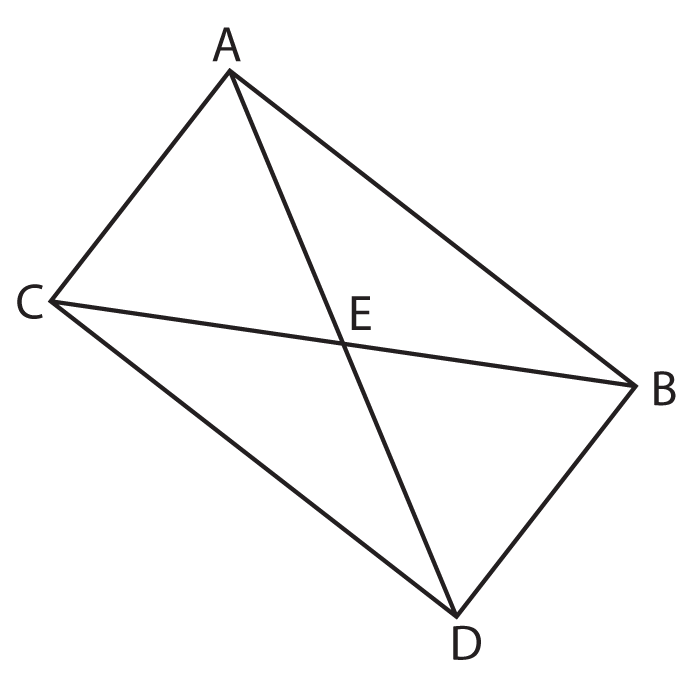
(I) AD and BC bisect each other at E
(II) Angle CD is 90°
72. ABCD is a square. What is the area of the triangle ABE?

(I) AB = 10
(II) CE = DE
73. What is the value of x – y?
(I) x = 5
(II) x + 2y = 2x + y
74. Is ABCD a square?

(I) BC is perpendicular to AD
(II) BE = EC
75. Is the integer x divisible by 3?
(I) The last digit in x is 3
(II) x + 5 is divisible by 6
76. Is x greater than y?
(I) 3x = 2k
(II) k = y2
77. Plane X flies at r miles per hour from A to B. Plane Y flies at S miles per hour from B to A. Both planes take off at the same time. Which plane flies at a faster rate? C is between A and B.
(I) C is closer to A than it is to B
(II) Plane X flies over C before plane Y
78. A sequence of numbers a1, a2, a3, ….. is given by the rule ![]() Does 3 appear in the sequence?
Does 3 appear in the sequence?
(I) a1 = 2
(II) a3 = 16
79. If a, b and c are digits, is a + b+ c a multiple of 8? A digit is one of the integers 0, 1, 2, 3, 4, 5, 6, 7, 8, 9.
(I) The three-digit number abc is a multiple of 8
(II) a × b × c is a multiple of 8
80. Which one of the two figures. ABCD or EFGH has the largest area?

(I) The perimeter of ABCD is longer than the perimeter of EFGH
(II) AC is longer than EG
PART-V
Directions (Qns. 81-100): In the of the following sentences four words or phrases have been underlined. Only one underlined part in each sentence is not acceptable in standard English. Pick up that part-(A) or (B, or (C), or (D). If there is no mistake mark (E).
81. The grant should go to the applicant
(A)
who the board thinks the trustee intended it
(B) (C)
for. No error.
(D) (E)
82. Many a box of oranges and grapefruits have
(A) (B)
been sent by relatives visiting Florida.
(C) (D)
No error.
(E)
83. Without interference by man, nature has its
(A) (B)
own way of purifying water through physical, chemical or by biology
(C) (D)
No error.
(E)
84. The Chairman, along with members of the board,
(A)
are meeting in a week-long session
(B) (C)
to discuss the company’s business strategy,
(D)
No error.
(E)
85. He had the privilege to be absent whenever
(A) (B) (C)
he had an attack of asthma. No error.
(D) (E)
86. He was filled with anger against those
(A) (B)
whom he believed had hurt or humiliated him.
(C) (D)
No error.
(E)
87. The use of public roads is seriously threatened
(A) (B)
by the freedom given or taken by the owners and drivers of motor cars.
(C) (D)
No error.
(E)
88. He laid for half an hour in an unconscious state
(A) (B) (C)
until a policemen picked him up. No error.
(D) (E)
89. The young mountaineer knows that he had
(A) (B) (C)
ten hours of darkness before him. No error.
(D) (E)
90. He is one of the wisest and noblest king
(A) (B)
that has ever lived. No error
(C) (D) (E)
91. He is trying his best to please his master whom
(A) (B)
he fears may be seriously offended by what has happened.
(C) (D)
No error.
(E)
92. In his earlier days he was a happy go lucky fellow
(A) (B)
but now he prefers working hard
(C)
to amuse himself. No error.
(D) (E)
93. The persecutors laid a heavy fine on an old man
(A) (B)
who being unable to pay the soldiers were dragging him to prison.
(C) (D)
No error.
(E)
94. The proverb means that when you
(A) (B)
can do a thing today do not put it off till tomorrow.
(C) (D)
No error.
(E)
95. He wishes to tax not only the luxuries of the rich
(A) (B) (C)
but also the necessaries of the poor. No error.
(D) (E)
96. Kingsley is one of the sincere student in our college.
(A) (B) (C) (D)
No error.
(E)
97. When he awoke he asked where I am. No error
(A) (B) (C) (D) (E)
98. The gentleman together with his wife and daughter
(A) (B) (C)
were drowned. No error.
(D) (E)
99. The film has just been exhibited in the city
(A) (B)
and everyone wanted to see it. No error
(C) (D) (E)
100. The girl said that she preferred the blue gown
(A) (B) (C)
than the pink one. No error.
(D) (E)
Latest Govt Job & Exam Updates: